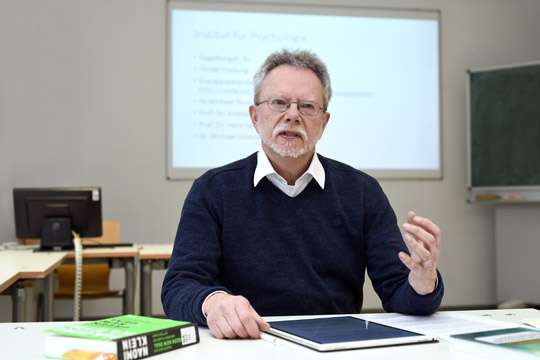Conscious energy use and savings
Freiburg, Jan 27, 2020
How can you get people to behave in a more energy-efficient way? Dr. Michael Stumpf from the Department of Psychology at the University of Freiburg is examining this question. In addition, in the Cluster of Excellence livMatS - Living, Adaptive and Energy-autonomous Materials Systems, he is researching how people adopt yet-to-be-developed material systems. Claudia Füßler recently sat down for a chat with him.
 Energy-conscious action is associated with effort and requires a consideration of the alternatives: The stand-by function, for example, is convenient, but consumes resources and costs money. Photo: Sandra Meyndt
Energy-conscious action is associated with effort and requires a consideration of the alternatives: The stand-by function, for example, is convenient, but consumes resources and costs money. Photo: Sandra Meyndt
Mr. Stumpf, what exactly is an environmental psychologist?
Michael Stumpf: We are interested in how humans perceive their environment, how they act in it, how they use it. I am mainly concerned with the use of energy. How can you get someone to behave in a more energy-efficient way?
How do people deal with energy?
Energy is often invisible, energy consumption is not an end in itself and people are often not even aware of the consumption of energy. Energy consumption is the unintended consequence of an activity: we want to bake cakes, for example, and need electricity for the stove. Therefore, an important first step is to make people aware that energy is being used and how much. In the second step, I can explain how to use and save energy more consciously.
Don’t most people know that by now?
It is indeed different today than it was 20 years ago. Back then, such information was more of an "aha" effect; today, it is used by many to open doors. However, it is also the case that there is still a lot to be done in terms of knowledge about consumption - for example, a television set’s stand-by mode. The same applies to knowledge about concrete options for action, i.e. how any one of us can save energy.
What is most likely to motivate people to be energy-conscious?
There is a whole range of factors that we systematically apply. In general, it is important to be clear: energy-conscious behavior always involves effort. People then ask themselves: Does it pay off? Financially? From the perspective of individual comfort? What is more important to me that I protect the environment or that my television is on stand-by and I can switch it on from the sofa at any time? One is the knowledge about possible problems and alternatives, the other is how this knowledge is evaluated, how important the possible effects of my actions are to me, how much I feel myself affected by them, whether I believe I can change something.

Role models, calls to action or individual feedback can motivate people to save energy, says Michael Stumpf. Photo: Thomas Kunz
What are things that work in terms of motivation?
We know, for example, that people like to orient themselves by what others do. Also, pleas and calls to action work quite well. A few years ago, for example, we sent an energy-saving tip to employees in the morning when they logged on to their PCs, such as “Today the sun is shining into the office, it's not worth turning on the heating.” Feedback on consumption and possible savings can also have a motivating effect, as can incentives such as a bonus for an e-car or ways of showing appreciation.
These are all incentives that are set from outside. What about the intrinsic, i.e. the inner motivation of a person to deal more consciously with energy?
It plays a major role and can be very different. If the intrinsic motivation is strong, there is little or no need for external incentives. The problem with external motivators is that the system often collapses as soon as the reward is lost. However, if an intrinsic motivation has been built up beforehand, the chances that the person will still continue to behave in an environmentally conscious manner increase.
How sustainable do you think movements such as Fridays for Future really are?
I don't think that this will fade away so quickly, there is a generation conflict involved: We live today at the expense of our children, who will have to pay for it in the future. The climate problem has been the most important issue in Germany for several months now. Our task, as climate researcher Hans Joachim Schellnhuber once said, is to avoid the uncontrollable and master the unavoidable.
In the livMatS Cluster of Excellence you are concerned with the investigation of psychological, philosophical and ethical implications of material systems. What exactly does that mean?
In livMatS, novel material systems are developed that combine certain properties. The project is based on four pillars. The first three are of a more technical nature; they explore the energy autonomy, durability and adaptability of these material systems. The fourth pillar is formed by the Öko-Institut Freiburg, the Department of Philosophy and us, the Department of Psychology at the University of Freiburg. In psychology, we want to predict how the materials still to be developed will be accepted by people. This is very exciting because acceptance research usually works on prototypes - but we don't have any at the moment.
Can you illustrate it with an example?
Take a façade for shading a house, which works independently: it changes according to the sunlight and repairs itself when it breaks down. Someone from biology, for example, now has the idea that this can be done wonderfully from fungus-like structures. We psychologists then say to the developers: Be careful, maybe not everybody wants to live in a house with a fungal facade, that could be a rather negative attribute. We have therefore compiled a list of possible attributes - those that have more positive and those that have more negative connotations. This should help the developers. In addition, with cognitive-affective maps, we are further developing a technique from the mind-mapping field, which we want to use to visualize such attributes and their linkeage.

